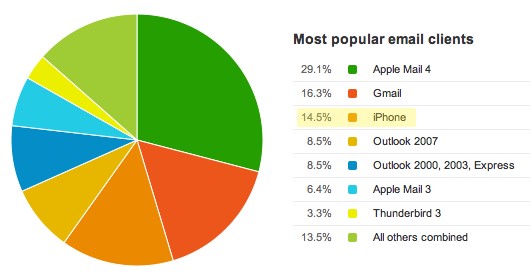Before you send out your first marketing campaign, you’ll need to decide on the layout of your content.
With improvements in HTML designs, you have many options available. Different column layouts work better for different types of campaigns, so you’ll want to check that the one you choose works for your list of subscribers.
Get the beginner’s guide to email.
What are emails with single-column or two-column layouts?
A single-column email has a set order and hierarchy, no matter which device the subscriber uses to view the content. It uses a single table in HTML code, so the content scales and fits easily within any screen size.
Single columns were the standard for many years. As every email client (mobile, web, or desktop) uses different implementations of backend code to show the content, it was easier to design uniform marketing campaigns for different devices with single-column emails.
Improvements in email clients, on the other hand, made it possible to use two-column, responsive emails in your marketing campaigns.
On average, subscribers now open at least 50% of all emails on their mobile devices.
Source: Campaign Monitor
Two-column (or multi-column) emails respond to the different clients and devices customers use to open your content. You can’t predict which platform someone will use to access your emails, so you’ll want to make sure you design content that looks great, whatever the client.
Pros and cons of single-column email designs
You can still use single-column layouts to design stunning looking campaigns. People have shorter attention spans now than ever before, meaning you’ll want to create engaging content, no matter what layout you choose.
The major benefits of single-column emails include:
- It uses a clear hierarchy with the most important information at the top and standard scrolling regardless of the client.
- Single-column emails are easy to optimize for mobile consumption.
- With a standardized, sequential flow of information, you can focus your message and give subscribers a CTA at the end.
The drawbacks of using single-column emails are:
- Since it’s a skinny design, it may not look great on desktops.
- It requires all subscribers to scroll through the entire email to find information.
- They can make text and buttons look oversized when viewed on different devices.
Pros and cons of two-column email designs
Just like websites display differently if someone opens them on their mobile or computer, two-column emails will adapt to the display.
When done correctly, double-column (or dynamic) emails can deliver different experiences based on the subscriber’s device.
Source: Campaign Monitor
Reasons to use two-column emails include:
- It gives subscribers a different experience, depending on the device.
- Text, images, and videos scale automatically to make it easier to scan information.
- They work great when the focus is images with little text in the content.
- You can add multiple CTAs in different blocks of content.
Why responsive emails may not work for you:
- Designing emails for all the different clients requires lots of testing.
- If done incorrectly, it can cause images, videos, or text to display incorrectly.
- They can make the content seem lacking if there aren’ enough images or content blocks.
How to measure the success of emails with single-column or two-column layouts
To find the best layout for your subscribers, you’ll want to check your device-specific open and click-through rates. If more customers use their mobiles to view your content, you’ll want to check what clients they use and design for that platform.
You’ll want to test different layouts to find the best design that supports all your subscribers. Increases in unsubscribe rates will show that your list members aren’t engaging with your designs.
Does it really matter?
Keeping up with your subscribers’ habits shows that you care about their experience. With more mobile-friendly solutions now possible in either single-column or double-column emails, you could also adapt the layout, depending on the content you want to share.
Create responsive email design with this guide.
What now?
Choosing a layout that uses single-column or two-column emails depends on your subscriber habits. More people are using mobile devices to scan emails, making single-column designs a valid marketing strategy.
At the same time, you can create two-column, responsive designs suitable for either desktop or mobile experiences. You’ll need to conduct some testing to see what design works best for you and your email lists.
For more tips on how to create responsive emails your subscribers will love, check out this blog post for designing emails without media queries.
